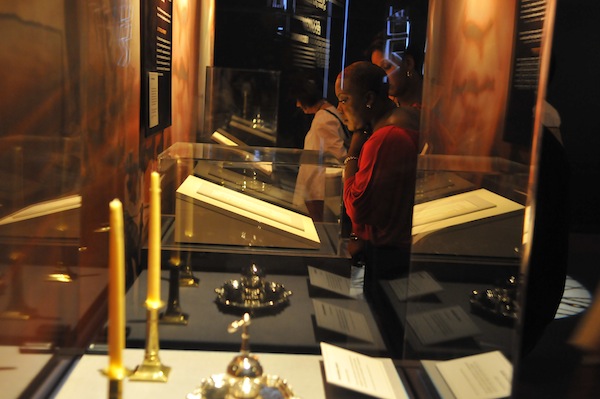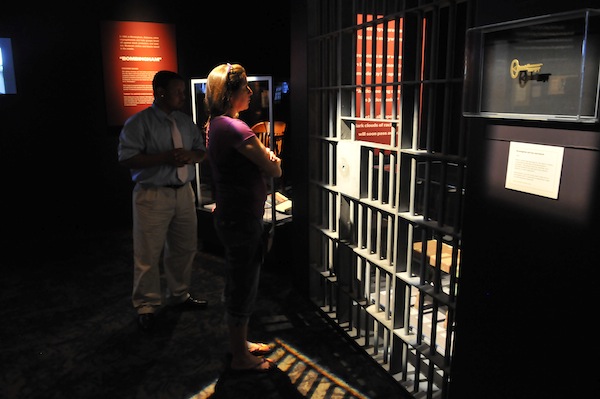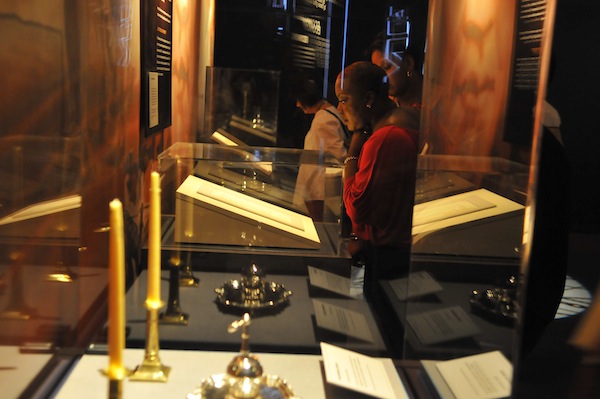
One culture’s imprint
By Bonita Buford, Gantt Center
Mournful voices chant; chains scrape across a floor; sobs and sporadic drums form the soundtrack as visitors step into America I AM: The African American Imprint, a sweeping historical exhibition outlining pivotal moments of courage, conviction and creativity. This multimedia presentation includes rare documents, photographs and more than two hundred original artifacts gathered in one place to demonstrate the economic, socio-political, cultural and spiritual impact African Americans have had on the United States and the world.
Mounted on either side of a passageway that leads to a cold, dimly lit replica of a dungeon are the Doors of No Return, two wooden slabs that were salvaged when Ghana’s Cape Coast Castle – one of many structures where slaves were held for transport — was demolished. Chains and shackles encased in the gallery reveal how slaves were restrained before being loaded onto ships headed for the New World.

Gantt Center visitors in Civil Rights Gallery
Life varied for Africans in America. Earthen vessels crafted by a South Carolina slave, known today as Dave the Potter, were utilitarian but were inscribed with original poems and Dave’s signature. Because it was illegal for slaves to read and write, signing his work was a bold act, punishable by death. Thomas Day, a free black man who owned slaves, left behind an incredible legacy in furniture, cabinetry, and other woodwork. Day’s marble-topped mahogany wash stand is displayed next to a Southern lady’s four-piece dresser set. The collection includes the requisite comb, brush and mirror and, unexpectedly, a silver-handled whip reminding viewers that reprimanding household servants was the order of the day.
Galleries filled with objects representing the abolishment of slavery, Reconstruction, and the Jim Crow era lead to one introducing the Civil Rights Movement. A replica of a jail cell commands the space. Visitors hear a door closing and peer into the cell. A 1963 photograph of Dr. Martin Luther King, Jr. in silhouette covers the rear wall; the small rusted iron bench in the center is where he sat for nine days in solitary confinement in Birmingham, Alabama. King’s voice rings out with excerpts from his landmark Letter from a Birmingham Jail.
James Brown sings his 1964 hit “I Feel Good” when guests turn the corner into the final gallery. Vinyl 45s share exhibition space with Muhammad Ali’s boxing robe and the tennis outfit Serena Williams wore when she was crowned 2009 Wimbledon Tennis Champion. The final display case houses Stevie Wonder’s harmonica and the artist-again-known-as Prince’s 2007 Super Bowl half-time show guitar.
With so many rare and unique artifacts, visitors to the Gantt Center leave the exhibition having spied at least one object of significance to them and a deeper appreciation of the African American imprint on the globe.

Gantt Center visitor views 1801 NYC Census
Recent Content
-
Artsarticle ·
-
Artsarticle ·
-
Artsarticle ·
